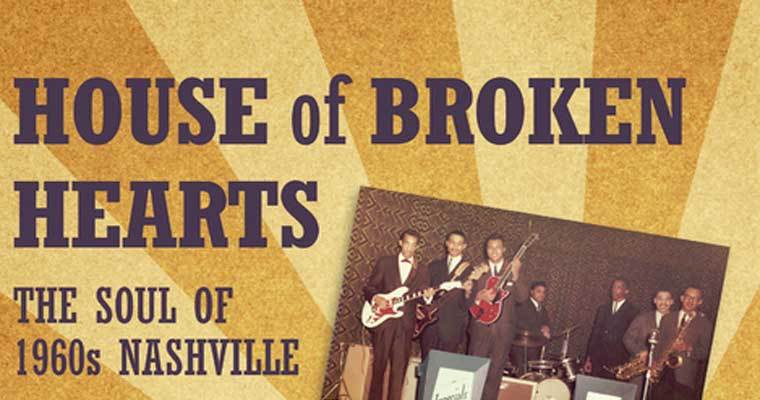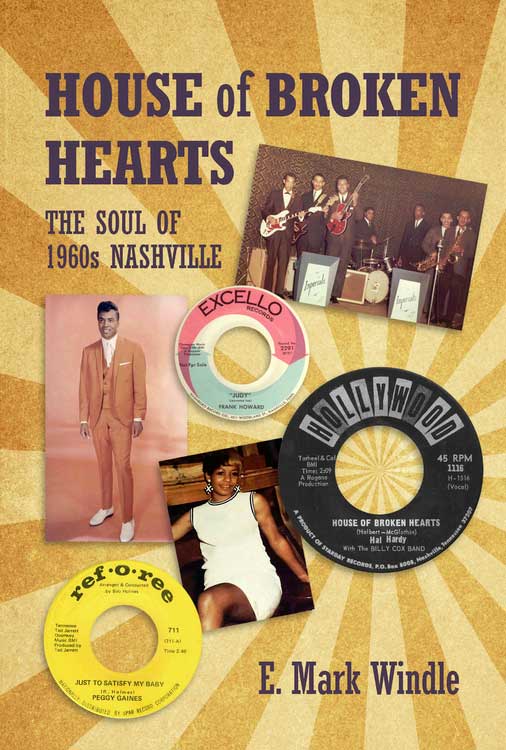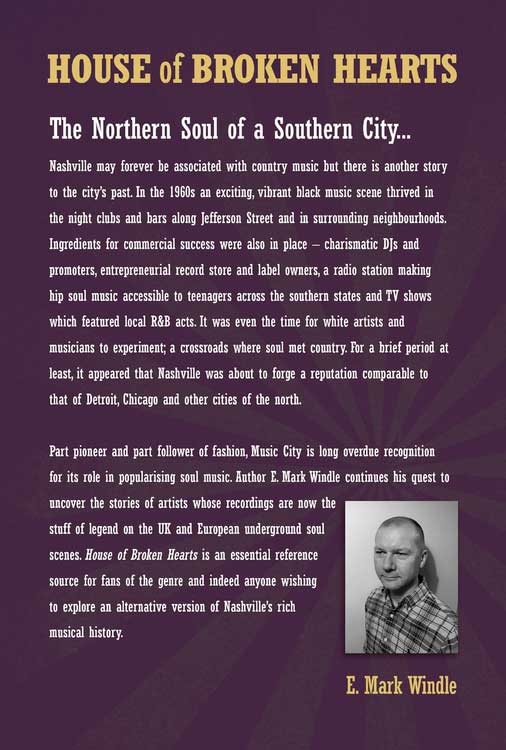House of Broken Hearts by E. Mark Windle
A new book on the soul of 1960s Nashville.

Regarding what has been pretty much an obsession with 1960s southern soul themes since I started writing some years ago, the latest project was undertaken in an attempt to resolve one nagging omission. A fair chunk of my travels (virtual and otherwise) has been spent researching the Carolinas, Virginia, Louisiana and a wee bit of Texas, to cover beach music, soul influenced garage bands and black vocal groups for It’s Better To Cry and then Rhythm Message. But I was always conscious that one particular southern state was well overdue attention.
Among the most obvious musical centres in Tennessee would be Memphis and Nashville. These cities may be separated by a couple of hundred miles - no distance at all in US terms of course – but both have rich and intriguing musical identities; to the casual observer, for culturally contrasting reasons.
Memphis’ musical heritage is undeniable, and there is no danger of it being eroded by the passage of time. Indeed it is comforting that there is an abundance of literature celebrating all aspects of the Memphis musical tapestry whether it be Beale Street, Sun Records, Stax, Graceland and rock ‘n’ roll, blues or jazz. As a writer looking for an R&B 'angle', I guessed that Stuart Cosgrove would maybe have it covered as his next plan after Detroit ’67 (no doubt adding a political slant to previous reference works by Peter Guralnik and the like).
So then, what of Nashville? Well, much of its soul music history has until recent years been obscured by the city’s accolade as the country music centre of the universe. The Grand Ole Opry and the Country Music Hall of Fame and Museum proudly stand testament to that. But to say that “Music City” is synonymous with country music is (technically) a contradiction. After all, the term was coined when the Fisk Jubilee Singers came to UK shores to perform their spirituals in the presence of Queen Victoria as part of their university fund raising effort. This would set the scene for future decades of race music, which would only be quashed by eventual dispersion of the local African-American community. Activities to redress the balance from the 1980s onwards include Nashville musician Fred James’ efforts to roll-call blues and soul singers to perform again and in some cases even to recommence recording careers; and a highly praised Night Train exhibition by the Country Music Hall of Fame and Museum, coordinated by museum editor Michael Gray. The CD spin-off from the exhibition was even a Grammy winner. And to this day, the artists from back in the day continue to sing, reminisce and be remembered by others who come to watch them perform regularly in a café off Murfreesboro Pike.
But what does 1960s Nashville have to offer specifically to soul fans from the UK and European underground scenes? Some are no doubt aware of the huge catalogue of Sound Stage 7 and related releases. Enthusiasts of a different genre have long loved the Louisiana swamp blues which found their way onto Ernie Young’s Excello. But to some younger generations or to those on the other side of the pond, Nashville soul music output sometimes appeared a little disconnected from the rest of what was going on in the music industry at the time. Was the R&B ‘thing’ in Nashville was just a bit of luck with record industry leaders finding a brief niche with the national soul explosion?
Truth is, it was there all the time. Everything just came together at the right time for soul music. As the back cover blurb of House of Broken Hearts explains:
“….In the 1960s an exciting, vibrant black music scene thrived on Jefferson Street and in surrounding neighbourhoods. Night clubs, bars and theatres provided a focal point for the development of R&B. Ingredients for success were all in place – home grown talent, venues, charismatic DJs and promoters, entrepreneurial record store owners, independent black owned labels, a radio station making hip soul music accessible to teenagers across the southern states, and TV shows which featured local R&B acts. It was even the time for white artists and musicians to experiment with black music; a crossroads where soul met country music. For a brief period at least, the future seemed bright….”
The purpose of this new book is to celebrate the individuals – not just the singers, but industry players, media drivers and record labels; bringing the spotlight once more back to this era. OK, so it’s written from a northern / rare soul enthusiast’s perspective; you’ll find the stories there of Jimmy Church, Frank Howard and the Commanders, Freddie North, Johnny Jones and the King Casuals, Joe Simon, Jackie Beavers, The Spidells and many more. But I hope you will discover more than a mere collection of biographies. It is story of dreams, exciting times, and harsh reality. Were it not for ill-planned urbanisation decisions as mentioned earlier which displaced the black community - and inevitably much of its musical culture – perhaps Nashville could have forged an R&B legacy comparable to cities of the north.
Music City is long overdue recognition for its role in popularising soul as a genre. The book cements part of this history with some thorough research and a whole lot of help from those veterans who still keep the flame alive. If you’re passing through Nashville, be sure to call by Carol Anne’s Cafe.
House of Broken Hearts is a 180 page paperback with over 100 colour images (label scans, photographs and memorabilia, many of which are made publicly available for the first time). Cover design by Jason Thornton, of Philly Sound fame. Pre-order available now until publication date 1 April 2017. RRP £19.99. Pre-order price £17.99 (10% discount from RRP). All orders will be dispatched on or just before publication.
Blurb and ordering details here...
https://a-nickel-and-a-nail.myshopify.com/collections/books/products/ssss





Recommended Comments